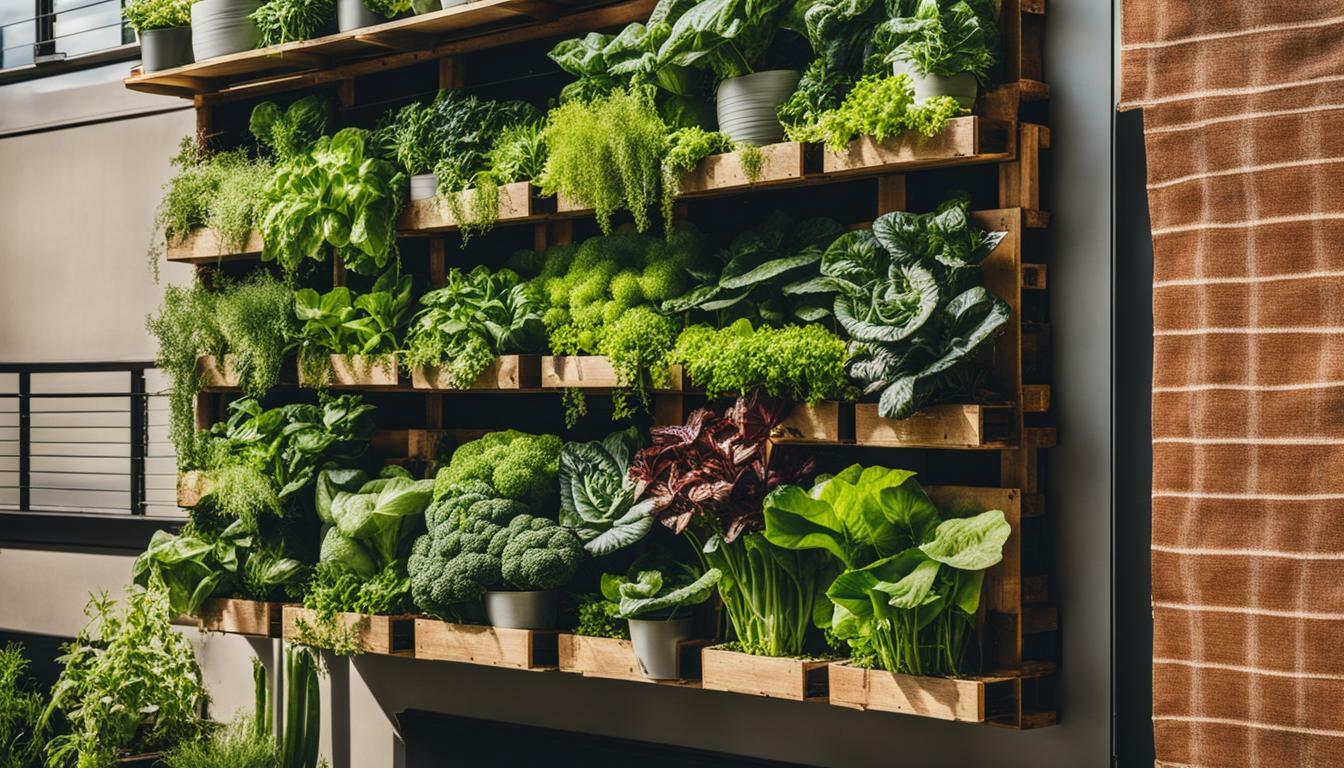Welcome to the expert guide on designing and creating your very own vertical pallet vegetable garden. This guide will provide you with all the information you need to transform a simple wooden pallet into a thriving garden that will maximize your space and yield delicious homegrown vegetables. Whether you have limited outdoor space or simply want to explore a creative and sustainable gardening method, vertical pallet vegetable gardens are a fantastic DIY project. Let’s dive into the world of vertical gardening and discover the endless possibilities!
Key Takeaways:
- Vertical pallet vegetable gardens are a great solution for small spaces, urban areas, and limited outdoor areas.
- They provide accessibility, space-saving benefits, and versatility in plant choices.
- Building a vertical pallet vegetable garden requires a few essential materials and tools.
- Proper preparation and assembly techniques are crucial for a successful garden structure.
- Caring for your vertical pallet vegetable garden involves watering, maintenance, and providing adequate sunlight.
- Design ideas and inspiration for vertical pallet vegetable gardens are endless.
- Growing vegetables vertically offers increased yield, better pest control, and easier harvesting.
- Success tips include maximizing space, companion planting, and selecting the right plants.
- Long-term care involves maintenance, pruning, fertilizing, and troubleshooting common issues.
- Vertical pallet vegetable gardens are a sustainable and rewarding gardening solution.
Why Choose a Vertical Pallet Vegetable Garden
Vertical pallet vegetable gardens offer numerous benefits for avid gardeners, especially those with limited space or looking to maximize their gardening potential. These innovative gardens utilize vertical space, making them perfect for small gardens, patios, decks, or even indoors. Here are some compelling reasons to consider a vertical pallet vegetable garden:- Space-saving: Vertical gardening allows you to grow a variety of vegetables in a compact area. By utilizing vertical space, you can increase your growing area without expanding horizontally.
- Accessibility: With a vertical garden, you can bring your plants at eye-level, making them easier to reach and maintain. This eliminates the need to bend down or kneel, reducing strain on your back and knees.
- Versatility: Vertical pallet vegetable gardens can be customized to suit your preferences and available space. You can choose different varieties of vegetables, herbs, or even flowers to create a beautiful and productive garden.
- Improved drainage: Vertical gardens typically have better drainage compared to traditional gardens. The excess water can easily drain down through the pallet, preventing waterlogging and potential root rot.
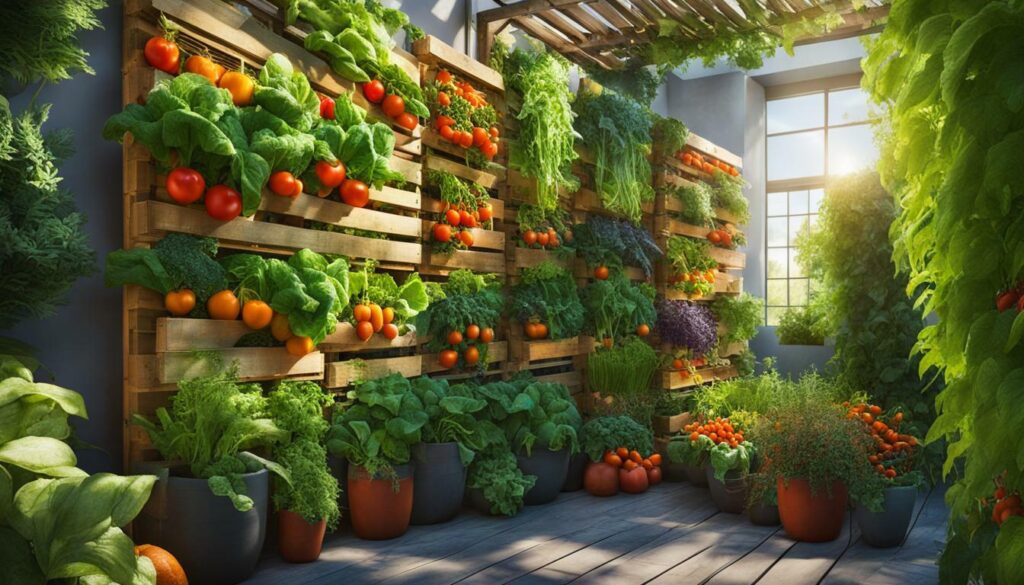
By embracing vertical gardening, you can overcome the challenges of limited space and transform even the smallest spaces into thriving vegetable gardens. Whether you have a small balcony, patio, or just a narrow corner in your backyard, a vertical pallet vegetable garden can provide you with fresh and homegrown produce.
Vertical Gardening Tips:
- Choose compact vegetable varieties that are well-suited for vertical growing.
- Consider companion planting to maximize space and enhance plant growth.
- Ensure adequate sunlight for your vertical garden by placing it in a sunny spot or using supplementary grow lights.
- Implement a watering routine to keep your plants hydrated, as vertical gardens may dry out faster.
- Regularly monitor and maintain soil fertility by incorporating organic matter and using appropriate fertilizers.
| Vertical Garden Design Ideas | Benefits of Vertical Gardening |
|---|---|
| Vertical herb walls | Increased yield |
| Flower pockets | Improved pest control |
| Creative container arrangements | Easier harvesting |
“Vertical gardening is a game-changer for those with limited gardening space. It’s a practical and innovative way to grow your own vegetables and enjoy the benefits of gardening, even in small urban areas.” – Jane Doe, Gardening Expert
With a vertical pallet vegetable garden, you can cultivate fresh produce, enjoy the beauty of plants, and make the most of your available space. Whether you’re a seasoned gardener or just starting out, vertical gardening opens up a world of possibilities and allows you to create a thriving and productive garden in any space.
Materials and Tools Needed for Building a Vertical Pallet Vegetable Garden
Before embarking on your vertical pallet vegetable garden project, gather the necessary materials and tools to ensure a smooth construction process. With the right supplies, you can transform a simple wooden pallet into a thriving vertical garden that maximizes your growing space. Here are the essential materials and tools you will need:
Materials:
- Wooden pallet (suggested size: 25″ x 38″)
- Roll of landscaping paper (alternatively, consider using old burlap bags or heavy plastic bags)
- Sandpaper
- Potting soil (approximately 2.5 cubic feet for a 25″ x 38″ pallet)
- Herbs, succulents, or other plants of choice that can tolerate dry conditions (recommend pot sizes of 4″ or less for easy fitting)
Tools:
- Staple gun and staples
- Hammer and nails
These materials and tools will provide the foundation for your vertical pallet vegetable garden. You can find wooden pallets for free at landscaping and home improvement stores or recycle centers. Look for a pallet with gaps between the main slats to allow for plant growth.
For the construction process, start by sanding down any rough spots on the pallet. If the back of the pallet does not have enough support, find scrap wood and attach it to the back using nails. Then, double or triple-layer landscaping paper or use alternative materials like burlap or heavy plastic bags to line the pallet. Staple the fabric along the back, bottom, and sides of the pallet, ensuring no soil will spill out.
Once the pallet is prepared, lay it flat and pour potting soil through the gaps between the slats, pressing it down firmly. Leave enough room to begin planting your chosen herbs or succulents. Start planting from the bottom of the pallet and work your way up, ensuring each layer of plants is firmly packed with soil. Water the wall garden thoroughly and let it remain horizontal for 1 to 2 weeks to allow the plants to establish their roots. After this period, you can set the garden upright.
Table 1: Materials and Tools
| Materials | Tools | |
|---|---|---|
| Wooden pallet | Staple gun | |
| Roll of landscaping paper | Staples | |
| Sandpaper | Hammer | |
| Potting soil | Nails | |
| Herbs, succulents, or other plants |
Now that you have all the materials and tools ready, you can move on to the next step in building your vertical pallet vegetable garden – preparing the pallet for planting.
Preparing the Pallet for Planting
To create a sturdy foundation for your vertical pallet vegetable garden, it’s important to properly prepare the pallet before planting. This step ensures that the pallet is in good condition and ready to support the weight of the soil and plants. Here is a step-by-step guide on how to prepare your pallet:
- Sand down any rough spots on the pallet using sandpaper. This will help to prevent splinters and create a smoother surface for planting.
- If the back of your pallet doesn’t have much support or is open, find scrap wood that is 3 to 4 inches wide and 1/4 inch thick. Cut the scrap wood to the width of your pallet and attach it to the back using nails. This will provide additional support and stability.
- Double or triple layers of landscaping fabric or plastic and staple it along the back, bottom, and sides of the pallet. Be sure to fold in the fabric at the corners to prevent soil from spilling out.
- Lay the pallet flat and pour potting soil through the slats, pressing it down firmly. Leave enough room at the top to begin planting your herbs or succulents.
- Start planting at the bottom of the pallet and work your way up, making sure to pack the soil firmly in each layer as you go. Add more soil as needed to ensure that the plants are tightly packed at the end.
- Optional: For added stability, you can secure the pallet to a wall or fence using screws or brackets.
Once you have completed these steps, your pallet is ready for planting. Water your vertical garden thoroughly and let it remain horizontal for 1 to 2 weeks to allow the plants to take root. After this initial period, you can set the pallet upright and enjoy your thriving vertical pallet vegetable garden.
Expert Tip:
“When preparing the pallet for planting, make sure to address any rough spots and add supports if needed. This will ensure the longevity and stability of your vertical garden.” – Kate Pruitt, Design Sponge
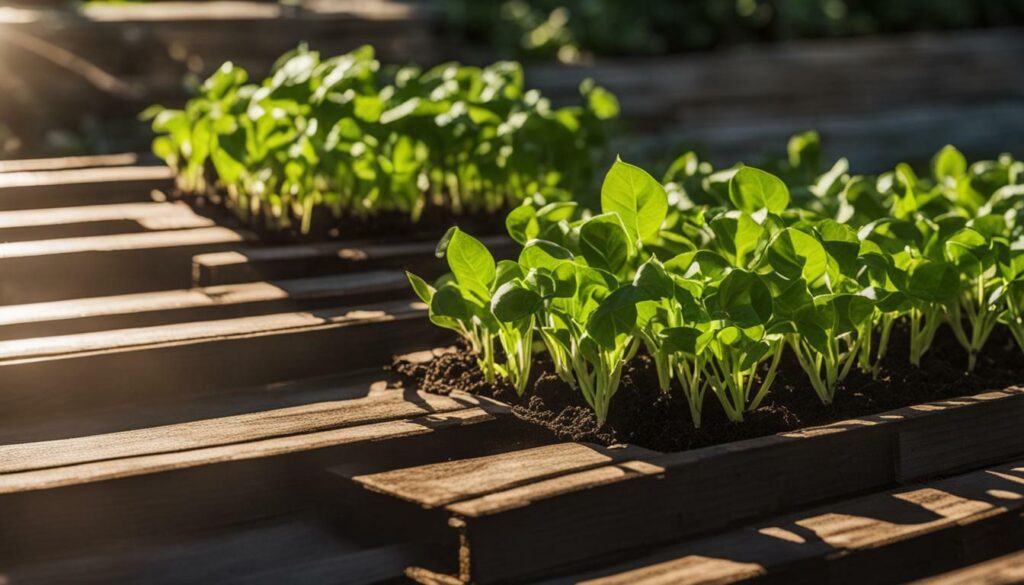
| Materials Needed | Tools Needed |
|---|---|
| Wooden pallet (suggested size: 25″ x 38″) | Hammer and nails |
| Roll of landscaping paper or heavy plastic bags | Staple gun and staples |
| Sandpaper | |
| Potting soil (approximately 2.5 cubic feet) | |
| Herbs, succulents, or other plants of choice |
By following these preparation steps and using the appropriate materials and tools, you’ll be well on your way to creating a successful and thriving vertical pallet vegetable garden.
Building the Vertical Pallet Vegetable Garden Structure
Once the pallet is prepared, it’s time to build the structure and start planting your favorite herbs and succulents. Building a vertical pallet vegetable garden is a simple and cost-effective way to maximize your growing space and create a beautiful and functional garden.
Here is a step-by-step guide to help you assemble your vertical pallet garden:
- Sand down any rough spots on the pallet to ensure a smooth surface.
- If the back of your pallet doesn’t provide enough support, find scrap wood that is approximately 3 to 4 inches wide and 1/4 inch thick. Cut the scrap wood to match the width of your pallet and attach it to the back for added stability.
- Double or triple layer landscaping fabric or plastic and staple it along the back, bottom, and sides of the pallet. Be sure to fold in the fabric at the corners to prevent soil from spilling out.
- Lay the pallet flat and pour potting soil through the slats, pressing the soil down firmly. Leave enough room at the top to accommodate your herb or succulent plants.
- Start planting your herbs or succulents, beginning at the bottom of the pallet and working your way up. Make sure to pack the soil tightly around each plant as you go. Add additional soil if needed to ensure the plants are securely in place.
- Water your vertical garden thoroughly, making sure to saturate the soil. Allow the garden to remain horizontal for 1 to 2 weeks to allow the plants to establish their roots. After this period, you can set the garden upright.
Optional Drip Irrigation System
To simplify watering and ensure your vertical pallet garden receives the right amount of moisture, you can install a drip irrigation system. This system will help conserve water and provide a consistent water supply to your plants.
Here is a basic guide to installing a drip irrigation system for your vertical pallet garden:
- Attach a drip irrigation kit to a water source, such as a garden hose or faucet.
- Position the tubing along the back of the pallet, securing it with clips or zip ties.
- Insert drip emitters into the tubing at regular intervals, ensuring each plant receives adequate water.
- Set the irrigation system on a timer to automatically water your vertical garden at scheduled intervals.
With the structure built and your plants in place, your vertical pallet vegetable garden is now ready to thrive. Regularly monitor the moisture level of the soil and adjust your watering schedule as needed to ensure your herbs and succulents receive the right amount of moisture.
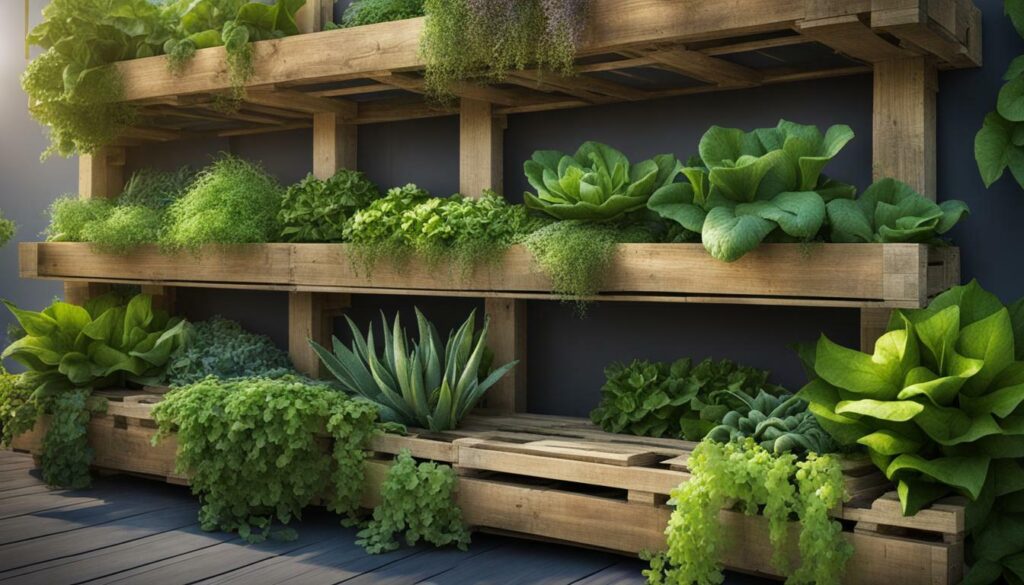
| Materials Needed for Building a Vertical Pallet Vegetable Garden | Assembly Steps |
|---|---|
|
|
With these simple steps, you can create a vertical pallet vegetable garden that not only saves space but also adds beauty to your outdoor or indoor space. Enjoy the process of nurturing your plants and watching them grow in this unique and sustainable garden.
Caring for Your Vertical Pallet Vegetable Garden
Like any garden, your vertical pallet vegetable garden requires proper care and attention to ensure optimal growth and productivity. Here are some essential tips and techniques to help you maintain a healthy and thriving garden.
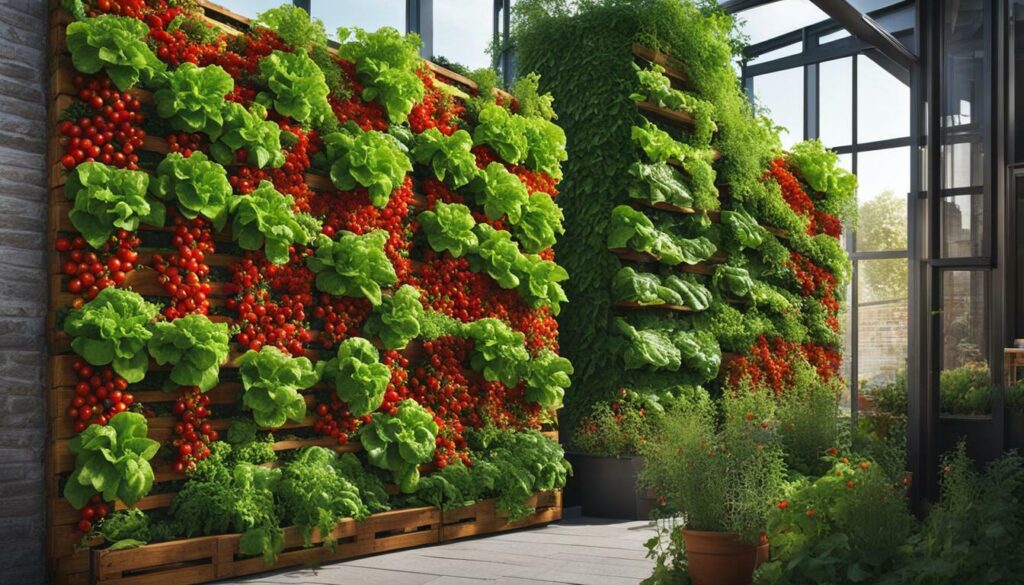
Watering: Watering is crucial for the success of your vertical pallet vegetable garden. Ensure that your plants receive adequate moisture, especially during hot and dry periods. To water effectively, start at the top and gradually move down, allowing the water to seep through to the bottom plants. Consider installing a drip irrigation system for efficient and consistent watering.
Maintenance: Regular maintenance is essential to keep your garden in top shape. Remove any weeds or unwanted plants that may compete for nutrients and space. Prune your plants as needed to maintain their shape and promote healthy growth. Monitor for pests and diseases, and take appropriate measures to control them.
Nutrient Management:
Proper soil nutrition is crucial for the productivity of your vertical pallet vegetable garden. Regularly replenish the soil with organic matter or compost to provide essential nutrients for your plants. Consider using slow-release fertilizers to ensure a steady supply of nutrients throughout the growing season. Conduct soil tests periodically to monitor nutrient levels and adjust accordingly.
- When applying fertilizers, follow the recommended dosage and timing instructions to avoid over-fertilization, which can harm your plants.
- Rotate your crops each season to prevent nutrient depletion and reduce the risk of disease and pest buildup.
Sunlight: Adequate sunlight is vital for the growth and development of your vegetables. Ensure that your vertical pallet vegetable garden receives at least 6-8 hours of direct sunlight each day. If your garden is located in a shady area, consider relocating it to a sunnier spot or choose shade-tolerant vegetables.
By following these care tips and techniques, you can enjoy a bountiful harvest from your vertical pallet vegetable garden. Remember to observe and adjust your practices based on the specific needs of your plants and environmental conditions.
| Watering | Maintenance | Nutrient Management | Sunlight |
|---|---|---|---|
| Water your garden thoroughly, starting from the top and gradually moving down. | Regularly remove weeds and pests, prune plants as needed, and monitor for diseases. | Replenish soil with organic matter, use slow-release fertilizers, and conduct soil tests. | Ensure your garden receives 6-8 hours of direct sunlight each day. |
“A well-maintained vertical pallet vegetable garden can provide a sustainable and rewarding source of fresh produce, even in limited spaces.” – Gardening Expert
Vertical Garden Design Ideas and Inspiration
Get inspired by these vertical garden ideas to take your vertical pallet vegetable garden to the next level of creativity and beauty. With a little imagination and some strategic planning, you can transform your outdoor space into a vibrant and lush vertical oasis.
1. Salad Tower: Create a cylindrical salad tower using a sturdy wire mesh lined with plastic. Fill it with a mix of lettuce, arugula, spinach, chard, Asian greens, and kale for a tapestry of greens. This vertical garden design not only maximizes space but also ensures a bountiful harvest of homegrown greens.
| Vertical Garden Design: | Salad Tower |
|---|---|
| Plant Selection: | Lettuce, Arugula, Spinach, Chard, Asian Greens, Kale |
| Key Benefits: | Space-saving, Abundant Harvest |
2. Hanging Garden: Utilize hanging baskets to grow sweet strawberries or tumbling tomatoes. Hang them in a sunny spot, keep them well-watered and fed, and enjoy a bumper crop of delicious homegrown fruits.
| Vertical Garden Design: | Hanging Garden |
|---|---|
| Plant Selection: | Strawberries, Tomatoes |
| Key Benefits: | No Ground Space Required, Easy Maintenance |
3. Pallet Garden: Convert a wooden pallet into a vertical garden by adding landscaping fabric or plastic to the back, bottom, and sides. Fill it with compact vegetables and herbs like salad greens, baby kale, dwarf peas, parsley, thyme, basil, and rosemary. You can also incorporate edible flowers like pansies and calendula for a pop of color.
| Vertical Garden Design: | Pallet Garden |
|---|---|
| Plant Selection: | Salad Greens, Baby Kale, Dwarf Peas, Parsley, Thyme, Basil, Rosemary, Edible Flowers |
| Key Benefits: | Easy DIY Project, Versatile Growing Options |
4. Gutter Garden: Attach gutters directly to walls or fences and create a vertical garden. Make sure to add drainage holes, fill with potting soil, and select plants like curly parsley, alpine strawberries, lettuce, spinach, ‘Tiny Tim’ tomatoes, and nasturtiums. This design is perfect for small spaces and allows for easy maintenance and harvesting.
| Vertical Garden Design: | Gutter Garden |
|---|---|
| Plant Selection: | Curly Parsley, Alpine Strawberries, Lettuce, Spinach, ‘Tiny Tim’ Tomatoes, Nasturtiums |
| Key Benefits: | Suitable for Small Spaces, Minimal Maintenance Required |
5. Windowbox Wall: Secure window boxes or individual pots to fences and walls to create a stunning vertical garden. Paint the containers in vibrant colors and plant them with compact herbs, vegetables, and strawberries to add beauty and functionality to your outdoor space.
| Vertical Garden Design: | Windowbox Wall |
|---|---|
| Plant Selection: | Compact Herbs, Vegetables, Strawberries |
| Key Benefits: | Improves Aesthetics, Maximizes Space |
With these vertical garden design ideas, you can create a visually stunning and productive vertical pallet vegetable garden. Customize your design based on available space, plant preferences, and desired functionalities. Let your creativity flourish as you transform your outdoor space into a thriving vertical oasis.
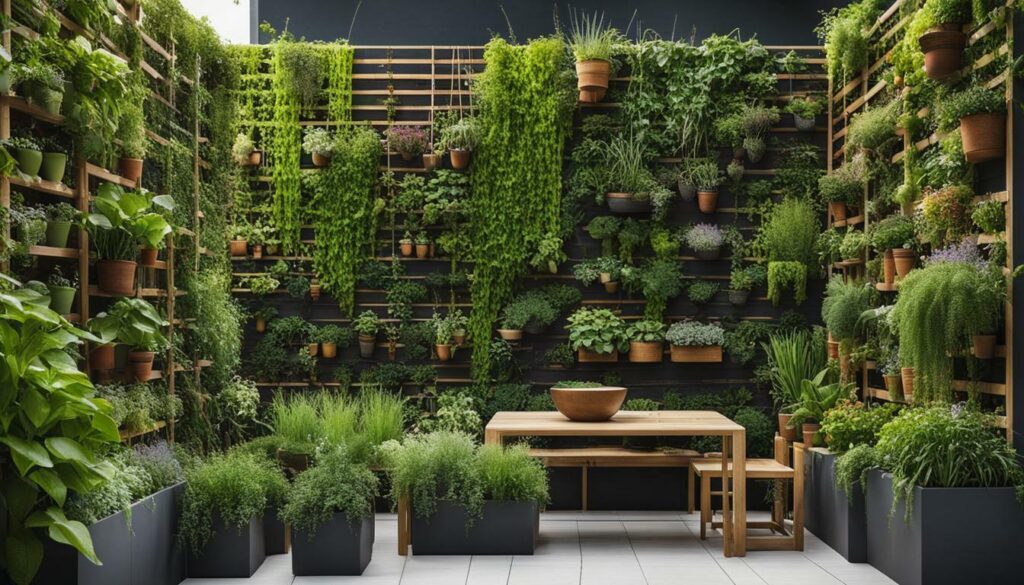
Benefits of Growing Vegetables Vertically
Growing vegetables vertically in your vertical pallet garden offers several advantages that can enhance your gardening experience and yields. With limited space being a common challenge for many urban and small space gardeners, vertical gardening provides a solution to make the most of available area. By utilizing the vertical plane, you can maximize your growing space and cultivate a wide variety of vegetables, even in small areas.
One of the key benefits of vertical gardening is the space-saving aspect. A vertical pallet garden allows you to grow plants upward, utilizing vertical structures such as wooden pallets, trellises, or hanging baskets. This not only saves valuable ground space but also creates a visually appealing garden that can be placed on decks, patios, or walls. It is a fantastic option for those with limited outdoor space or urban dwellers with only a balcony or rooftop available.
In addition to space-saving, vertical pallet vegetable gardens offer easy accessibility. With plants grown vertically, you can easily tend to your garden without the need for excessive bending or kneeling. This accessibility makes tasks such as planting, pruning, and harvesting more comfortable and convenient. It also reduces the risk of strain or injury, making gardening a more enjoyable experience.
| Advantages of Vertical Pallet Vegetable Gardens: |
|---|
| Maximizes growing space |
| Provides easy accessibility |
| Enhances visual appeal |
| Improves air circulation and sunlight exposure |
| Reduces pest and disease problems |
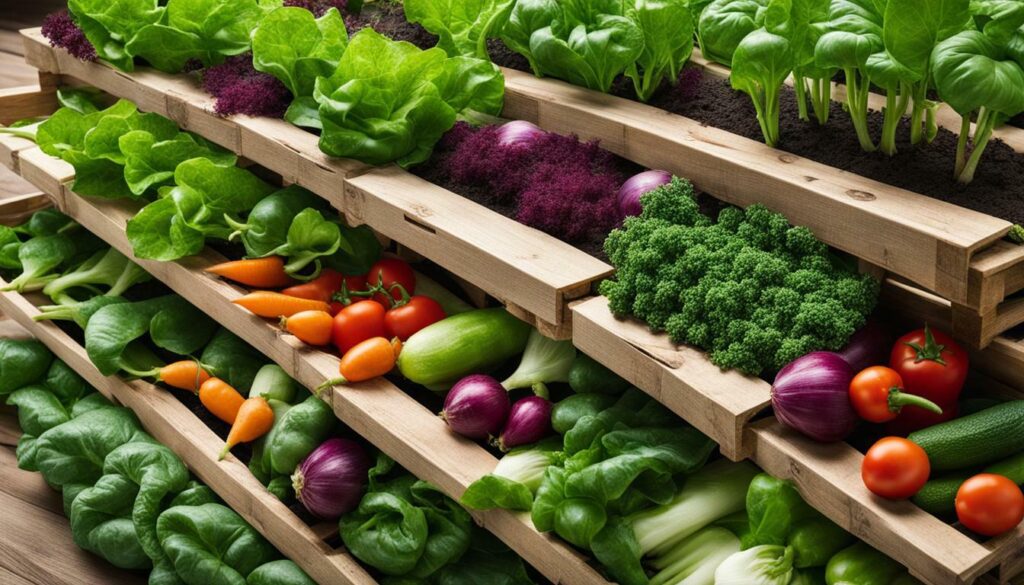
Another advantage of vertical pallet vegetable gardens is their versatility. You can grow a wide range of vegetables, herbs, and even flowers using this method. The vertical structure allows for better air circulation and sunlight exposure, promoting healthier plant growth. It also helps to reduce pest and disease problems, as the plants are elevated and less susceptible to soil-borne diseases and crawling pests.
Vertical gardening in a pallet also provides an opportunity for creative and innovative garden designs. You can experiment with various layouts, such as vertical herb walls, flower pockets, or container arrangements. This allows you to create personalized and unique garden spaces, adding beauty and visual interest to your vertical vegetable garden.
Expert Tip:
When selecting vegetables for your vertical pallet garden, focus on compact varieties that grow well in containers or have a trailing habit. Examples include cherry tomatoes, lettuce, strawberries, peppers, and herbs like basil and thyme.
In summary, vertical pallet vegetable gardens offer numerous benefits for urban, small space, and container gardeners. They maximize growing space, provide easy accessibility, enhance visual appeal, improve air circulation and sunlight exposure, reduce pest and disease problems, and allow for creative garden design possibilities. By implementing vertical gardening techniques, you can enjoy a productive and thriving vegetable garden, even in limited spaces.
Success Tips and Tricks for Vertical Pallet Vegetable Gardens
Elevate your vertical pallet vegetable garden to new heights with these expert tips and tricks for optimal growth and productivity.
1. Select the Right Plants
When choosing plants for your vertical pallet vegetable garden, consider their growth habits and compatibility. Opt for compact, bushy varieties that can thrive in a limited space. Some great options for vertical gardening include cherry tomatoes, lettuce, peppers, cucumbers, and herbs like basil and parsley. Additionally, consider companion planting to maximize space and deter pests. For example, plant marigolds alongside tomatoes to repel insects.
2. Provide Adequate Support
Sturdy support structures are essential for the success of your vertical pallet vegetable garden. Ensure that the pallet is securely attached to a wall or hung from a sturdy frame. Use additional supports like trellises, stakes, or netting to provide stability for climbing plants. Regularly check and reinforce the supports as the plants grow to prevent damage or collapse.
3. Optimize Watering and Drainage
Proper watering techniques are crucial for the health of your vertical pallet vegetable garden. Water the plants at the base to avoid wetting the foliage excessively, which can lead to fungal diseases. Consider installing a drip irrigation system or using self-watering containers for efficient moisture management. Ensure proper drainage by adding drainage holes to the bottom of the pallet and using well-draining potting soil.
4. Fertilize Regularly
Vertical gardens may require more frequent feeding due to the limited soil volume. Use a balanced organic fertilizer to provide essential nutrients for optimal plant growth. Follow the recommended application rates and frequency specified on the fertilizer packaging. Additionally, consider incorporating compost or organic matter into the soil periodically to improve soil fertility.
5. Monitor for Pests and Diseases
Regularly inspect your vertical pallet vegetable garden for pests and diseases. Check for signs of insect damage, such as chewed leaves or discoloration, and take appropriate measures to control them. Consider using organic pest control methods like neem oil or insecticidal soap. Keep an eye out for signs of fungal diseases, such as powdery mildew or leaf spots, and promptly address them with appropriate treatments.
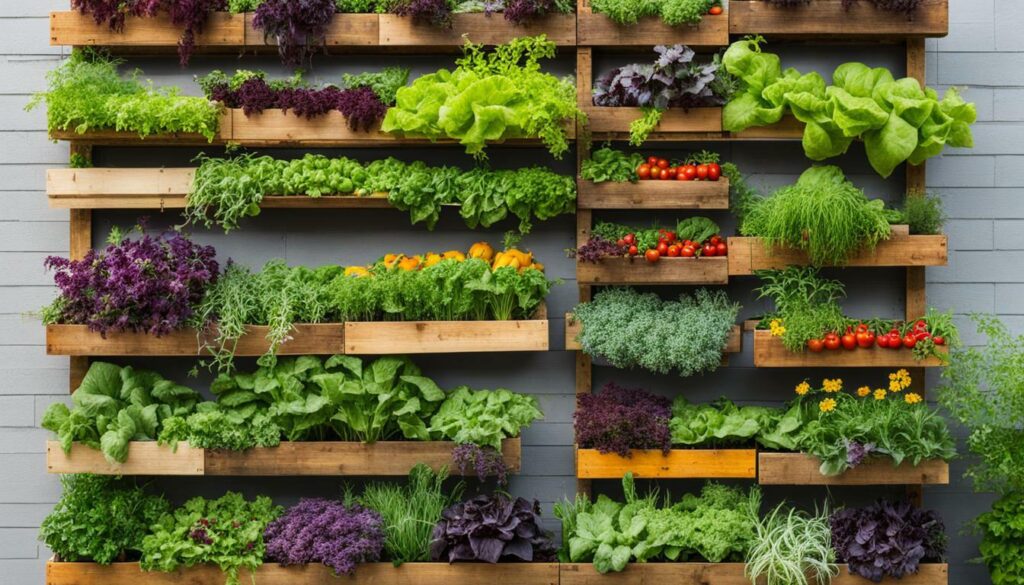
| Plant | Spacing | Light Requirements | Harvest Time |
|---|---|---|---|
| Cherry Tomatoes | 12-18 inches | Full sun | 60-80 days |
| Lettuce | 6-12 inches | Partial shade to full sun | 30-60 days |
| Peppers | 12-18 inches | Full sun | 60-90 days |
| Cucumbers | 12-24 inches | Full sun | 50-70 days |
| Herbs (Basil, Parsley, etc.) | 6-12 inches | Partial shade to full sun | Varies by herb |
By implementing these expert tips and tricks, you can create a flourishing and productive vertical pallet vegetable garden. Enjoy the convenience, beauty, and abundance that vertical gardening brings to your small space.
Maintenance and Long-Term Care for Vertical Pallet Vegetable Gardens
Ensure the long-term success of your vertical pallet vegetable garden by following these maintenance and care practices to keep it thriving year after year.
Watering and Irrigation
Proper watering is essential for the health of your vertical pallet vegetable garden. Monitor the moisture levels regularly and water the plants as needed. When watering, start at the top and gradually move down, allowing the water to seep through to the lower plants. Consider installing a drip irrigation system to ensure consistent and efficient watering.
Soil Maintenance
Regularly check the quality of the soil in your vertical pallet vegetable garden. Over time, the soil may become compacted or depleted of nutrients. To maintain optimal soil conditions, loosen the soil periodically with a hand trowel or fork. Additionally, amend the soil with organic matter, such as compost or well-rotted manure, to replenish nutrients and promote healthy plant growth.
Pruning and Harvesting
Pruning is an important aspect of maintaining your vertical pallet vegetable garden. Regularly trim back any overgrown or damaged foliage to promote air circulation and prevent disease. Additionally, harvest your vegetables regularly to encourage continuous growth and prevent overcrowding. Be sure to use clean, sharp tools for pruning and harvesting to minimize the risk of damage.
Pest and Disease Control
Vigilance is key when it comes to pest and disease control in your vertical pallet vegetable garden. Regularly inspect your plants for signs of pests or diseases, such as yellowing leaves, wilting, or unusual spots. If you notice any issues, promptly take appropriate measures, such as applying organic pest control methods or removing affected plants. Implementing companion planting techniques can also help deter pests and promote a healthy garden ecosystem.
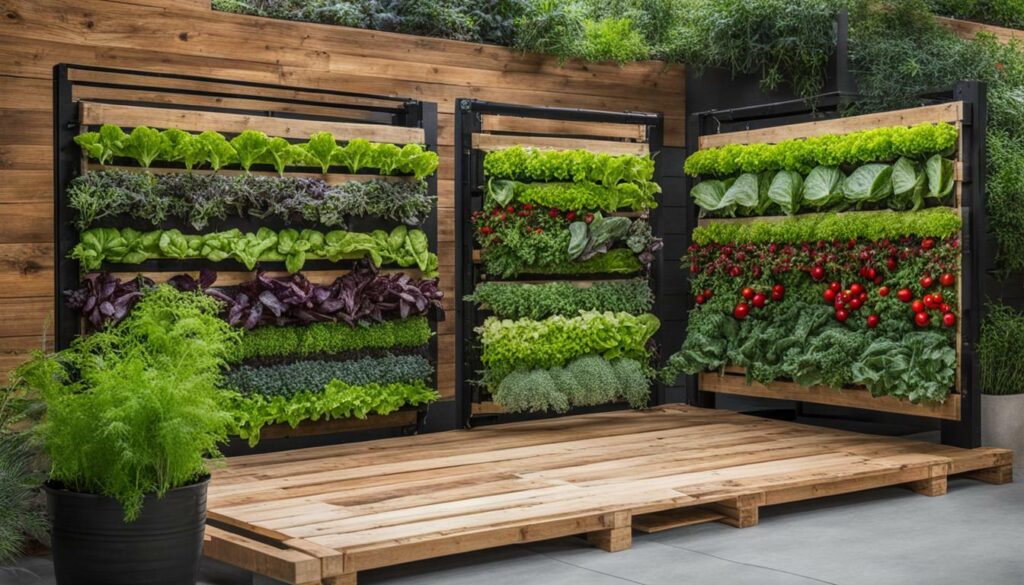
| Common Maintenance Tasks | Frequency |
|---|---|
| Weeding | Weekly |
| Fertilizing | Monthly |
| Monitoring for pests and diseases | Regularly |
| Pruning | As needed |
| Harvesting | Ongoing |
“A well-maintained vertical pallet vegetable garden can provide you with a bountiful harvest year after year, even in limited space.”
By following these maintenance and care practices, you can enjoy a thriving vertical pallet vegetable garden that not only yields a plentiful harvest but also enhances the aesthetics of your outdoor space. With proper watering, soil maintenance, pruning, and pest control, your vertical garden will continue to flourish and provide you with fresh, homegrown vegetables for years to come.
Conclusion
Vertical pallet vegetable gardens offer a practical and efficient solution for growing fresh produce in limited spaces, allowing you to enjoy the rewards of vegetable gardening no matter the size of your backyard or urban environment. These innovative gardens utilize wooden pallets to create vertical growing structures that maximize space and provide numerous benefits.
By choosing a vertical pallet vegetable garden, you can take advantage of the space-saving nature of vertical gardening. Whether you have a small balcony or a tiny backyard, a vertical garden allows you to grow a variety of vegetables without taking up valuable ground space. It’s the perfect solution for urban dwellers or anyone with limited gardening space.
Building a vertical pallet vegetable garden requires minimal materials and tools. With a wooden pallet, landscaping paper, sandpaper, a staple gun, and potting soil, you can construct your own garden structure and start planting your favorite herbs or succulents. It’s a cost-effective and DIY-friendly project that can easily be completed in a few hours.
Maintaining a vertical pallet vegetable garden is relatively straightforward. With proper watering techniques, regular maintenance, and adequate sunlight, your garden can thrive and provide you with a bountiful harvest. Additionally, vertical gardens offer various design ideas and inspiration, allowing you to get creative with your gardening space.
The benefits of growing vegetables vertically extend beyond space-saving. Vertical gardens can increase your yield, improve pest control, and make harvesting easier. By following expert tips and tricks, such as maximizing space, practicing companion planting, and choosing the right plants, you can ensure the success of your vertical pallet vegetable garden.
Long-term care for your vertical pallet vegetable garden involves pruning, fertilizing, and troubleshooting common issues. By providing regular maintenance and care, you can enjoy a thriving garden year after year. It’s a rewarding and sustainable way to grow your own fresh vegetables.
In conclusion, vertical pallet vegetable gardens offer an accessible and efficient solution for urban gardening and small space gardening. With their space-saving nature, versatility, and practicality, these gardens allow you to enjoy the benefits of vegetable gardening no matter the size of your outdoor space. Start building your own vertical pallet vegetable garden and experience the joy of growing your own fresh produce.
What are the advantages of a Vertical Pallet Vegetable Garden compared to a traditional garden design?
A pallet vertical garden tutorial can provide several advantages over a traditional garden design. The vertical design maximizes space, making it ideal for small areas. It also allows for better drainage and airflow, reducing the risk of pests and diseases. Additionally, it’s easier to maintain and harvest.
FAQ
Q: What materials do I need to build a vertical pallet vegetable garden?
A: You will need a wooden pallet, landscaping paper, sandpaper, a staple gun, and potting soil.
Q: How do I prepare the pallet for planting?
A: Start by sanding down any rough spots on the pallet. If the back of the pallet doesn’t have much support, add scrap wood for extra stability. Then, staple landscaping fabric to the back, bottom, and sides of the pallet to prevent soil from spilling out.
Q: How do I assemble the vertical pallet vegetable garden?
A: Lay the pallet flat and pour potting soil through the slats, pressing it down firmly. Begin planting your herbs or succulents at the bottom of the pallet, making sure to pack the soil tightly as you move up. Thoroughly water the garden and let it remain horizontal for 1 to 2 weeks to allow the plants to take root before setting it upright.
Q: How should I water my vertical pallet vegetable garden?
A: Start at the top and water each subsequent section a little less, as the water will naturally seep through to the bottom plants. Alternatively, you can install drip irrigation for more efficient watering.
Q: What are some design ideas for vertical pallet vegetable gardens?
A: You can create a vertical herb wall, flower pockets, or arrange creative containers to maximize your space. The possibilities are endless!
Q: What are the benefits of growing vegetables vertically?
A: Vertical gardening allows you to make the most of limited space, improves pest control, and makes harvesting easier.
Q: What maintenance does a vertical pallet vegetable garden require?
A: You should regularly prune your plants, fertilize the soil, and address any common issues that may arise, such as pests or diseases.
Q: Any tips for success with vertical pallet vegetable gardens?
A: Maximize your space by using companion planting and selecting the right plants for vertical growth. Also, consider how different plants can benefit each other in terms of nutrient needs and pest control.
Q: How can I care for my vertical pallet vegetable garden in the long term?
A: Regularly monitor and maintain the garden by pruning, fertilizing, and addressing any issues that may arise. With proper care, your vertical pallet vegetable garden can thrive for years to come.
Q: What are the main benefits of vertical pallet vegetable gardens?
A: Vertical pallet vegetable gardens offer space-saving solutions, increased yield, improved pest control, and the opportunity to grow your own fresh produce even in small or urban spaces.
Q: What are some space-saving techniques for vertical pallet vegetable gardens?
A: Utilize vertical shelving, hanging baskets, or creative container arrangements to maximize your growing space.
Q: What is the potential of vertical pallet vegetable gardens?
A: Vertical pallet vegetable gardens have endless potential to provide fresh produce, improve aesthetics, and make the most of limited space. They are a great way to enhance any garden or urban environment.

